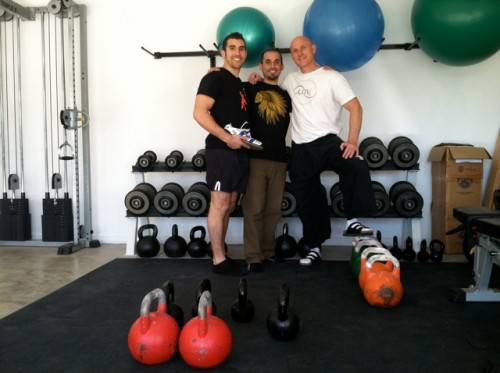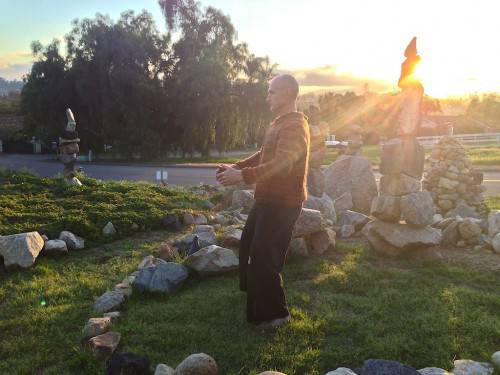What is Balance? (Pt. 1)
Happy Monday to You!
I had a lovely weekend.
Last Thursday, Mike Salami and Jonny Suarez came to see me for some help. Mike is one of the country’s top ranked Kettlebell competitors.
He’s been having some challenges with developing arm pump during his heavy training sessions and competitions.
Jonny is a Chek Level 3 Practitioner, so I know Mike had a thorough going over before getting to me. We worked through a number of functional diagnostic tests and I reaffirmed some of Johnny’s testing and gave them suggestions for improving blood flow to Mike’s arms.
I also looked at Mike’s technique. I found several ways I can improve his performance and decrease stress on his arms. Unfortunately, there are a variety of methods commonly taught by Kettlebell instructors around the world that aren’t very biomechanically sound and often lead to problems.
Literally the day before Mike was here, I was working with another woman that who is working with a trainer using kettlebells and she had the same basic technique challenges. I’ve seen many kettlebell lovers learning to love pain all over the world due to these misunderstandings.
It won’t be long and Jonny and I will have Mike back on top of his game, and the kettlebell game at large! He’s fit, young, strong and willing. Just the perfect combination in an athlete that is ready for some solid coaching.
Friday I went to Encinitas and enjoyed a good massage and a nice long steam bath. Then, I went home and didn’t do much of anything!
I had all sorts of plans about all the things I wanted to do, but once I got relaxed at home, I spent most of my time meditating and drawing diagrams for the project I’m currently developing. This was a nice balance between doing and not-doing.
Saturday, I came to my office (I call it Heaven here) and had a lovely, relaxing day meditating and working on my project. I drew more diagrams and planned and plotted away until late in the afternoon. Amidst it all, I got into the gym for a butt-blaster of a squat and lunge workout. That’s still with me today!
Sunday was another nice easy day for me. I enjoyed some tai-chi out in the garden at home with Vidya. Here you can see the beauty of the setting sun and my little rock sanctuary.
WHAT IS BALANCE (Pt. 1)
Balance is a word that implies a state somewhere between too much and too little.
The concept of balance applies to our bodies, our minds, our use of self, and our relationships with persons, places and things, to name a few. Because human beings and their lives are so complex, balance is somewhat of an illusive concept to understand, and often even more challenging for people to apply.
This week, my focus will be on different aspects of what it means to create balance in our lives.
What Is Balance?
Simply said, balance is a state in which we are not deficient, yet not burdened with excess either. Too much of anything causes problems. Not enough of the essentials we need, such as food, water, exercise, and rest, and we are off balance and often suffering.
LOVe and Balance
The word love is really a word that carries the same meaning as tai-chi (yin~yang). If we break the word down as though it were a code, this is how it translates based on my own experiences and investigations:
L = Desire (yin)
0 = Zero (Unconditional Love or Pure Potential)
Ve = Volt electron (will or yang), the electromotive force of the universe.
If we have excessive desires, we often act in ways that are irrational. If we have no desires, we may be labeled as depressed, or apathetic.
The first step toward finding balance in life is to love yourself and care for yourself.
Since you are 50% of every relationship you can ever have, loving and caring for yourself is the first, easiest, and most assuring way to offer something to any others you may share a relationship with.
To love yourself means to be honest about what your needs are, and to meet those needs with regard to:
– Rest
– Activity/participation
– Food and water, and
– What it is that constitutes “being happy” for you.
Indicators Of Balance In Your Life
In the excellent book, Mindsight by Daniel Siegel, MD, Dr. Siegel takes a deep and insightful look into what constitutes well-being, or balance in a person’s life.
Interestingly, when he explains the functions of the brain region called the prefrontal cortex, he shares that the functions of the prefrontal cortex are all essential components of well-being, which I equate to as the same as functional balance in our lives.
The prefrontal area has nine functions:
• regulation of energy/information
• attunement to others
• emotional/ affective balance, so that we have vitality without rigidity or chaos
• response flexibility
• fear modulation– soothing the amygdala
• insight
• empathy
• morality: knowing the greater good and enacting it
• intuition– supported by the neural net which connects nerves in the intestines and heart to the brain
If we go a little further and add:
– Postural balance
– Nutrition/hydration balance
– Sleep balance
– Exercise balance, and
– Healthy instincts,
we end up with a pretty well defined package that includes most relevant aspects of human body-mind function and integration.
It is worth noting that without creating balance in the areas I’ve added to Dr. Siegel’s prefrontal cortex (well-being) functions, the qualities he attributes to the experience of well-being begin to diminish quickly.
We must always remember that the body and the mind are as two sides of a coin; neither has any functional value without the other.
For example, if you look at studies done on prisoners, they have found that by doing things like giving prisoners more exposure to outside light, exercise, better food, better drinks, and even changing the color of their rooms and surroundings, that they are noticeably calmer, less violent.
On the other hand, I’ve never met anyone, even with advanced training that can maintain the qualities here attributed to well-being if the qualities of posture, nutrition, hydration, sleep, exercise, and having healthy instincts are not managed effectively.
Sure David Carradine could do this as the Kung Fu Master, but don’t forget, that’s Hollywood! The deserts and mountains are home to many dead bodies of various masters who couldn’t manage these essential relationships that you don’t see on TV.
In conclusion then, balance, as I’ve referred to it here, exemplifies a more comprehensive state of being, called “well-being”.
Well-being is a state of effective body-mind integration. Well-being is a balancing act that requires your conscious awareness, your ongoing participation. As we go through the series this week, I’ll share more about balancing your body-mind and life.
Right now, it’s time to go balance some rocks; any practice at balance is good practice if you put it to work.
Love and chi,
Paul Chek
PS: My zen In The Garden workshop is this coming Saturday. There’s still a little space left if you want to join me and learn to create some balance, fun, and increase your life-force!

